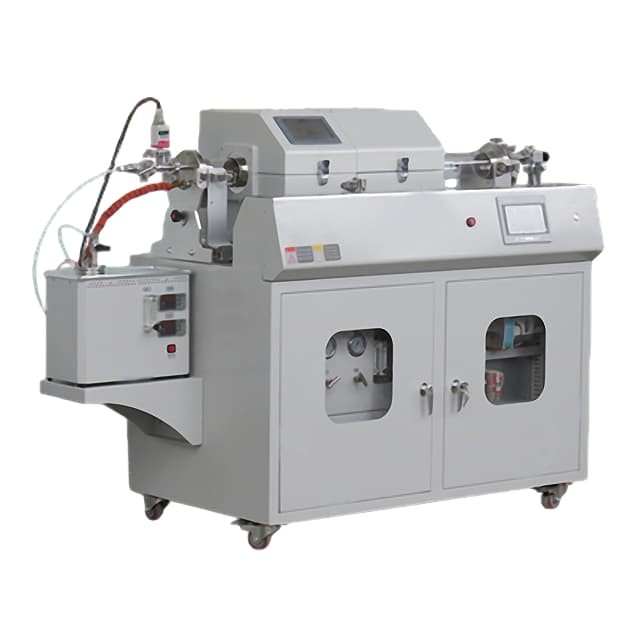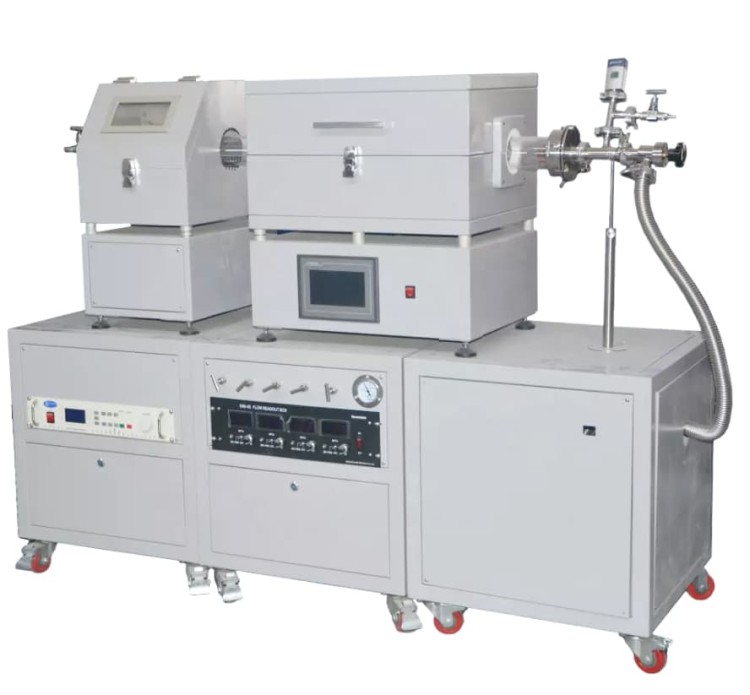
CVD & PECVD Furnace
Chemical Vapor Deposition CVD Equipment System Chamber Slide PECVD Tube Furnace with Liquid Gasifier PECVD Machine
Item Number : KT-PE12
Price varies based on specs and customizations
- Max. temperature
- 1200 ℃
- Constant work temperature
- 1100 ℃
- Furnace tube diameter
- 60 mm
- Heating zone length
- 1x450 mm
- Heating rate
- 0-20 ℃/min
- Sliding distance
- 600mm
Shipping:
Contact us to get shipping details Enjoy On-time Dispatch Guarantee.
Why Choose Us
Reliable PartnerEasy ordering process, quality products, and dedicated support for your business success.
Introduction
The Slide PECVD Tube Furnace With Liquid Gasifier PECVD Machine is a versatile and high-performance system designed for a wide range of thin film deposition applications. It features a 500W RF plasma source, slide-out furnace, precise gas flow control, and a vacuum station. The system offers advantages such as automatic plasma matching, high-speed heating and cooling, programmable temperature control, and a user-friendly interface. It is widely used in research and production environments for depositing thin films in various industries, including electronics, semiconductors, and optics.
Applications
Slide PECVD Tube Furnace With Liquid Gasifier PECVD Machine finds its applications in:
- Chemical Vapor Deposition (CVD)
- Plasma Enhanced Chemical Vapor Deposition (PECVD)
- Thin film deposition
- Solar cell fabrication
- Semiconductor processing
- Nanotechnology
- Materials science
- Research and development
Different temperature and setup CVD systems available




Principle
The Slide PECVD Tube Furnace With Liquid Gasifier PECVD Machine employs low-temperature plasma to generate a glow discharge in the process chamber's cathode (sample tray). The glow discharge (or another heat source) raises the sample's temperature to a predetermined level. Then, controlled amounts of process gas are introduced, undergoing chemical and plasma reactions to form a solid film on the sample's surface.
Features
The Slide PECVD Tube Furnace With Liquid Gasifier PECVD Machine offers numerous benefits to users:
- Enhanced power generation for solar cell wafers: The innovative graphite boat structure significantly improves the power output of solar cells.
- Elimination of color difference in tubular PECVD cells: This equipment effectively addresses the issue of color variation in tubular PECVD cells.
- Wide output power range (5-500W): The RF plasma automatic matching source provides a versatile range of output power, ensuring optimal performance for various applications.
- High-speed heating and cooling: The furnace chamber sliding system enables rapid heating and cooling, reducing processing time. Auxiliary forced air circulation further accelerates the cooling rate.
- Automated sliding movement: The optional sliding movement feature allows for automatic operation, enhancing efficiency and reducing manual intervention.
- Precise temperature control: PID programmable temperature control ensures accurate temperature regulation, supporting remote and centralized control for added convenience.
- High-accuracy MFC mass flowmeter control: The MFC mass flowmeter precisely controls source gases, ensuring a stable and consistent gas supply.
- Versatile vacuum station: The stainless steel vacuum flange with multiple adapting ports accommodates various vacuum pump station configurations, ensuring a high vacuum degree.
- User-friendly interface: The CTF Pro 7-inch TFT touch screen controller simplifies program setting and allows for easy analysis of historical data.
Advantages
- RF plasma automatic matching source, wide 5-500W output power range stable output
- Furnace chamber sliding system for high speed heating and short time cooling, auxiliary fast cooling and automatic sliding movement are available
- PID programmable temperature control,excellent control accuracy and support remote control and centralized control
- High accuracy MFC mass flowmeter control, source gases premixing and stable gas supply speed
- Stainless steel vacuum flange with various adapting port to meet different vacuum pump station setup, good sealing and high vacuum degree
- CTF Pro applies one 7 inches TFT touch screen controller, more friendly program setting and history data analysis
Safety Advantage
- Kindle Tech tube furnace owns over current protection and over temperature alarming function, furnace will turn off the power automatically
- Furnace build in thermal couple detecting function, furnace will stop heating and alarm will be on once broken or failure detected
- PE Pro support power failure restarting function,furnace will resume the furnace heating program when power is incoming after failure
Technical specifications
| Furnace model | KT-PE12-60 |
| Max. temperature | 1200℃ |
| Constant work temperature | 1100℃ |
| Furnace tube material | High purity quartz |
| Furnace tube diameter | 60mm |
| Heating zone length | 1x450mm |
| Chamber material | Japan alumina fiber |
| Heating element | Cr2Al2Mo2 wire coil |
| Heating rate | 0-20℃/min |
| Thermal couple | Build in K type |
| Temperature controller | Digital PID controller/Touch screen PID controller |
| Temperature control accuracy | ±1℃ |
| Sliding distance | 600mm |
| RF Plasma unit | |
| Output Power | 5 -500W adjustable with ± 1% stability |
| RF frequency | 13.56 MHz ±0.005% stability |
| Reflection Power | 350W max. |
| Matching | Automatic |
| Noise | <50 dB |
| Cooling | Air cooling. |
| Gas precise control unit | |
| Flow meter | MFC mass flow meter |
| Gas channels | 4 channels |
| Flow rate | MFC1: 0-5SCCM O2 MFC2: 0-20SCMCH4 MFC3: 0- 100SCCM H2 MFC4: 0-500 SCCM N2 |
| Linearity | ±0.5% F.S. |
| Repeatability | ±0.2% F.S. |
| Pipe line and valve | Stainless steel |
| Maximum Operating Pressure | 0.45MPa |
| Flow meter controller | Digital Knob controller/Touch screen controller |
| Standard vacuum unit(Optional) | |
| Vacuum pump | Rotary vane vacuum pump |
| Pump flow rate | 4L/S |
| Vacuum suction port | KF25 |
| Vacuum gauge | Pirani/Resistance silicon vacuum gauge |
| Rated vacuum pressure | 10Pa |
| High vacuum unit(Optional) | |
| Vacuum pump | Rotary vane pump+Molecular pump |
| Pump flow rate | 4L/S+110L/S |
| Vacuum suction port | KF25 |
| Vacuum gauge | Compound vacuum gauge |
| Rated vacuum pressure | 6x10-4Pa |
| Above specifications and setups can be customized | |
Standard Package
| No. | Description | Quantity |
| 1 | Furnace | 1 |
| 2 | Quartz tube | 1 |
| 3 | Vacuum flange | 2 |
| 4 | Tube thermal block | 2 |
| 5 | Tube thermal block hook | 1 |
| 6 | Heat resistant glove | 1 |
| 7 | RF plasma source | 1 |
| 8 | Precise gas control | 1 |
| 9 | Vacuum unit | 1 |
| 10 | Operation manual | 1 |
Optional Setup
- In tube gases detecting and monitoring,like H2, O2 and so on
- Independent furnace temperature monitoring and recording
- RS 485 communication port for PC remote control and data exporting
- Insert gases feeding flow rate control,like mass flowmeter and float flowmeter
- Touch screen temperature controller with versatile operator friendly functions
- High vacuum pump station setups, like vane vacuum pump,molecular pump,diffusion pump
Warnings
Operator safety is the top important issue! Please operate the equipment with cautions. Working with inflammable& explosive or toxic gases is very dangerous, operators must take all necessary precautions before starting the equipment. Working with positive pressure inside the reactors or chambers is dangerous, operator must fellow the safety procedures strictly. Extra caution must also be taken when operating with air-reactive materials, especially under vacuum. A leak can draw air into the apparatus and cause a violent reaction to occur.
Designed for You
KinTek provide deep custom made service and equipment to worldwide customers, our specialized teamwork and rich experienced engineers are capable to undertake the custom tailoring hardware and software equipment requirements, and help our customer to build up the exclusive and personalized equipment and solution!
Would you please drop your ideas to us, our engineers are ready for you now!
FAQ
What Is PECVD Method?
What Is Mpcvd?
What Is PECVD Used For?
What Is Mpcvd Machine?
What Are The Advantages Of PECVD?
What Are The Advantages Of Mpcvd?
What Is The Difference Between ALD And PECVD?
Are CVD Diamonds Real Or Fake?
What Is The Difference Between PECVD And Sputtering?
4.9
out of
5
I'm amazed by the quick delivery and the quality of the product. It's a game-changer for our lab.
4.8
out of
5
The Slide PECVD tube furnace has exceeded our expectations. It's a valuable addition to our research facility.
4.7
out of
5
This PECVD machine is a lifesaver! It has helped us achieve remarkable results in our research.
4.9
out of
5
The durability of this product is exceptional. It has withstood rigorous use in our lab.
4.8
out of
5
The technological advancements in this PECVD system have revolutionized our research capabilities.
4.7
out of
5
I highly recommend this product. It's worth every penny and has enhanced our research efficiency.
4.9
out of
5
The Slide PECVD tube furnace is a fantastic investment. It has accelerated our research progress significantly.
4.8
out of
5
This PECVD system is user-friendly and has simplified our research procedures.
4.7
out of
5
The technical support provided by KINTEK SOLUTION is outstanding. They're always ready to assist us.
4.9
out of
5
The Slide PECVD tube furnace has revolutionized our research methodology. It's a must-have for any lab.
4.8
out of
5
This PECVD machine is a game-changer. It has enabled us to achieve groundbreaking results in our research.
REQUEST A QUOTE
Our professional team will reply to you within one business day. Please feel free to contact us!
Related Products

Customer Made Versatile CVD Tube Furnace Chemical Vapor Deposition Chamber System Equipment
Get your exclusive CVD furnace with KT-CTF16 Customer Made Versatile Furnace. Customizable sliding, rotating, and tilting functions for precise reactions. Order now!

RF PECVD System Radio Frequency Plasma-Enhanced Chemical Vapor Deposition RF PECVD
RF-PECVD is an acronym for "Radio Frequency Plasma-Enhanced Chemical Vapor Deposition." It deposits DLC (Diamond-like carbon film) on germanium and silicon substrates. It is utilized in the 3-12um infrared wavelength range.

Learn about Cylindrical Resonator MPCVD Machine, the microwave plasma chemical vapor deposition method used for growing diamond gemstones and films in the jewelry and semi-conductor industries. Discover its cost-effective advantages over traditional HPHT methods.

915MHz MPCVD Diamond Machine Microwave Plasma Chemical Vapor Deposition System Reactor
915MHz MPCVD Diamond Machine and its multi-crystal effective growth, the maximum area can reach 8 inches, the maximum effective growth area of single crystal can reach 5 inches. This equipment is mainly used for the production of large-size polycrystalline diamond films, the growth of long single crystal diamonds, the low-temperature growth of high-quality graphene, and other materials that require energy provided by microwave plasma for growth.

Vacuum Hot Press Furnace Machine Heated Vacuum Press
Discover the advantages of Vacuum Hot Press Furnace! Manufacture dense refractory metals & compounds, ceramics, and composites under high temp and pressure.

Controlled Nitrogen Inert Hydrogen Atmosphere Furnace
KT-AH Hydrogen atmosphere furnace - induction gas furnace for sintering/annealing with built-in safety features, dual housing design, and energy-saving efficiency. Ideal for lab and industrial use.

Non Consumable Vacuum Arc Induction Melting Furnace
Explore the benefits of Non-Consumable Vacuum Arc Furnace with high melting point electrodes. Small, easy to operate & eco-friendly. Ideal for laboratory research on refractory metals & carbides.

1200℃ Controlled Atmosphere Furnace Nitrogen Inert Atmosphere Furnace
Discover our KT-12A Pro Controlled atmosphere furnace - high precision, heavy duty vacuum chamber, versatile smart touch screen controller, and excellent temperature uniformity up to 1200C. Ideal for both laboratory and industrial application.

Spark Plasma Sintering Furnace SPS Furnace
Discover the benefits of Spark Plasma Sintering Furnaces for rapid, low-temperature material preparation. Uniform heating, low cost & eco-friendly.

VHP Sterilization Equipment Hydrogen Peroxide H2O2 Space Sterilizer
A hydrogen peroxide space sterilizer is a device that uses vaporized hydrogen peroxide to decontaminate enclosed spaces. It kills microorganisms by damaging their cellular components and genetic material.

Vacuum Heat Treat and Pressure Sintering Furnace for High Temperature Applications
Vacuum pressure sintering furnaces are designed for high temperature hot pressing applications in metal and ceramic sintering. Its advanced features ensure precise temperature control, reliable pressure maintenance, and a robust design for seamless operation.

Manual High Temperature Heated Hydraulic Press Machine with Heated Plates for Lab
The High Temperature Hot Press is a machine specifically designed for pressing, sintering and processing materials in a high temperature environment. It is capable of operating in the range of hundreds of degrees Celsius to thousands of degrees Celsius for a variety of high temperature process requirements.

Automatic High Temperature Heated Hydraulic Press Machine with Heated Plates for Lab
The High Temperature Hot Press is a machine specifically designed for pressing, sintering and processing materials in a high temperature environment. It is capable of operating in the range of hundreds of degrees Celsius to thousands of degrees Celsius for a variety of high temperature process requirements.
Related Articles

Plasma Enhanced Chemical Vapor Deposition (PECVD): A Comprehensive Guide
Learn everything you need to know about Plasma Enhanced Chemical Vapor Deposition (PECVD), a thin film deposition technique used in the semiconductor industry. Explore its principles, applications, and benefits.

Understanding PECVD: A Guide to Plasma-Enhanced Chemical Vapor Deposition
PECVD is a useful technique for creating thin film coatings because it allows for the deposition of a wide variety of materials, including oxides, nitrides, and carbides.

PECVD Furnace A Low-Power and Low-Temperature Solution for Soft Matter
PECVD (Plasma Enhanced Chemical Vapor Deposition) furnaces have become a popular solution for the deposition of thin films on soft matter surfaces.

Advantages of Using CVD Tube Furnace for Coating
CVD coatings have several advantages over other coating methods, such as high purity, density, and uniformity, making them ideal for many applications in various industries.

A Step-by-Step Guide to the PECVD Process
PECVD is a type of chemical vapor deposition process that uses plasma to enhance the chemical reactions between the gas-phase precursors and the substrate.

The Role of Plasma in PECVD Coatings
PECVD (Plasma Enhanced Chemical Vapor Deposition) is a type of thin film deposition process that is widely used for creating coatings on various substrates. In this process, a plasma is used to deposit thin films of various materials onto a substrate.

A Comprehensive Guide to PECVD Equipment Maintenance
Proper maintenance of PECVD equipment is crucial to ensure its optimal performance, longevity, and safety.

Comparing the Performance of PECVD and HPCVD in Coating Applications
Although both PECVD & HFCVD are used for coating applications, they differ in terms of deposition methods, performance, and suitability for specific applications.

Understanding the PECVD Method
PECVD is a plasma-enhanced chemical vapor deposition process that is widely used in the production of thin films for various applications.

A Comprehensive Guide to Split Tube Furnaces: Applications, Features
It is accurate that a split tube furnace is a type of laboratory equipment that consists of a hollow tube or chamber that can be opened to allow for the insertion and removal of samples or materials being heated.

Why PECVD is Essential for Microelectronic Device Fabrication
PECVD (Plasma-Enhanced Chemical Vapor Deposition) is a popular thin film deposition technique used in microelectronics device fabrication.

A beginner's guide to MPCVD machines
MPCVD (Microwave Plasma Chemical Vapor Deposition) is a process used to deposit thin films of material onto a substrate using plasma generated by microwaves.